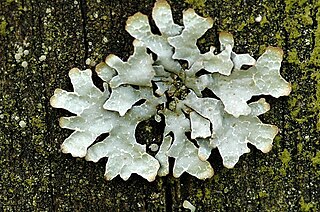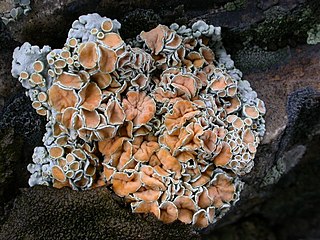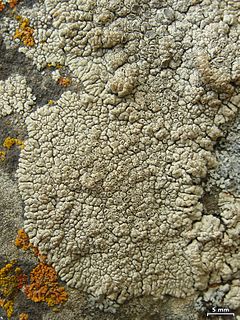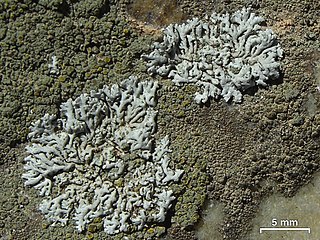
Parmelia sulcata is a foliose lichen in the family Parmeliaceae. It is very tolerant of pollution and has a cosmopolitan distribution, making it one of the most common lichens. It harbours a unicellular Trebouxia green algal symbiont.

The Acarosporaceae are a family of fungi in the order Acarosporales. Members of this family have a widespread distribution, and are mostly lichenized with green algae. According to a 2021 estimate, the family contains 11 genera and about 260 species. The family is characterised by a hamathecium formed of paraphysoids.

Caloplaca saxicola is a small bright orange crustose lichen that grows on rock all over the world. It is commonly called rock firedot lichen, jewel lichen or rock jewel lichen.

Lecanora is a genus of lichen commonly called rim lichens. Lichens in the genus Squamarina are also called rim lichens. Members of the genus have roughly circular fruiting discs (apothecia) with rims that have photosynthetic tissue similar to that of the nonfruiting part of the lichen body (thallus). Other lichens with apothecia having margins made of thallus-like tissue are called lecanorine.

Calvitimela is a lichen genus in the family Tephromelataceae. Members of the family Tephromelataceae are crustose lichens with green photobionts and lecideine or lecanorine apothecia. The species in Calvitimela have lecideine apothecia, are saxicolous and are primarily found in alpine to arctic regions.

Rhizoplaca is a genus of lichenized fungi in the family Lecanoraceae. Members of the genus are commonly called rimmed navel lichens because of their umbilicate growth form and lecanorine apothecia, also rock-posy lichen and rockbright. The genus has a widespread distribution and contains 11 species.

Nephroma is a genus of medium to large foliose lichens. The genus has a widespread distribution. They are sometimes called kidney lichens, named after the characteristic kidney-shaped apothecia that they produce on the lower surface of their lobe tips, which often curl upwards and thus are visible from above. Sterile specimens that do not have apothecia can look somewhat like Melanelia, Peltigera, Platismatia, or Asahinea. Most species grow either on mossy ground or rocks, or on trees.

Pertusaria is a large genus of warty crustose lichens in the Pertusariaceae family. The fruiting bodies are usually modified apothecia that immersed in warts on the main body (thallus) with small holes for the spores to emerge, similar to ostioles, or are fully above and lecanorine (spore bearing discs surrounded by a ring of tissue similar to the tissue of the thallus. Members of the genus are commonly called wart lichens.

Acarospora socialis is a usually bright yellow areolate to squamulose crustose lichen in the family Acarosporaceae that grows up to 10 cm wide, mostly on rock in western North America. It is among the most common lichens in the deserts of Arizona and southern California. It grows on sandstone, intrusive and extrusive igneous rock such as granitics, in all kinds of exposures to sunlight, including vertical rock walls. It is found in North America, including areas of the Mojave Desert and Sonoran Desert region, to Baja California Sur. It is the most common yellow member of its genus in southwestern North America. It sometimes, but rarely, grows on other soil crusts. It is a pioneer species.
Caloplaca durietzii, or Durietz's orange lichen, a smooth surfaced yellowish orange crustose areolate lichen with elongated lobes that grows on wood or bark in southwestern North America. It is commonly seen growing on old junipers in Joshua Tree National Monument in the Mojave Desert. It is in the Caloplaca fungus genus of the Teloschistaceae family.

Lecanora muralis(Protoparmeliopsis muralis) is a waxy looking, pale yellowish green crustose lichen that usually grows in rosettes radiating from a center (placodioid) filled with disc-like yellowish-tan fruiting bodies (apothecia). It grows all over the world. It is extremely variable in its characteristics as a single taxon, and may represent a complex of species. The fruiting body parts have rims of tissue similar to that of the main nonfruiting body (thallus), which is called being lecanorine. It is paler and greener than L. mellea, and more yellow than L. sierrae. In California, it may be the most common member of the Lecanora genus found growing on rocks (saxicolous).

Oxneria fallax, also known as the hooded sunburst lichen, is a small yellow-orange to red-orange foliose lichen that grows on bark or rarely on rock or bone. It is found all over the world except very dry areas, with 10 species common in North America. The nonfruiting body (thallus) grows in rosettes to 3 cm in diameter. The rosettes sometimes coalesce with each other. The lobes may appear divided at the tips. It is sometimes tightly appressed to the substrate (adnate), and sometimes not. The fruiting bodies (apothecia) are lecanorine, meaning that they are disc-like with a ring or rim of tissue around the disc that is made of tissue similar to the thallus. The tips of the lobes form hood shaped soralia that produce powdery greenish yellow soredia. It prefers growing on elm or oak bark, but can also be found on rocks, bone, or other wood types. Lichen spot tests on the surface are K+ purple, C−, KC−, and P−.

Lobothallia alphoplaca, the variable sunken disk lichen, is a creamy gray to brown, placoidioid areolate lichen that grows on rock in on rock and sometimes moss. It prefers growing on siliceous rocks. It is found in Europe, central Asia, and North America, where it grows in the southwestern deserts to central California. The center has numerous crowded and deformed apothecia with rims of thallus-like tissue (lecanorine). With dark reddish or grayish brown to black discs. Lichen spot tests on the thallus and apothecia are C−, and KC−, with tests on the cortex K+ red, P+ orange, or K−, P− and on the medulla K+ red, and P+ orange. It produces norstictic acid, constictic acid, or salazinic acid as secondary metabolites.

Acarospora obnubila is a dull brown squamulose areolate crustose lichen that may grow up to 4 mm in diameter or with squamules scattered among other lichens. They are common in Arizona, southern California, and Baja California. They grow by themselves on acidic rock in full sunlight. Squamules measure up to 2 mm in diameter and are round to irregular, with have a stipe. They may also grow on members of the genus Aspicilia (lichenicolous). Competition for space with other lichens stimulates longer stipes to develop, whereby the squamules may overlay other lichens.

Acarospora thamnina is a shiny, black tinged, variously brown squamulose crustose lichen. It has a linear growth pattern, growing along cracks in boulders. It can be found in North America to Alaska and Maine, from the coast to inland locations, also in the Ural Mountains and Novaya Zemlya in Russia. It commonly grows either among, or on other lichens. It grows a longer stipe so its squamules can grow over other lichens when there is competition for space. When it forms thick clumps it is easily identified with its elevated squamules and thick stipes. It grows on acidic rock in full sunlight.

Protoparmelia badia is a species of crustose lichen in the family Parmeliaceae. It is a widely distributed, common species that grows on rocks.

Candelariella antennaria, or the pussytoes eggyolk lichen, is a lichen commonly distributed in North America, and has been observed in South America, Asia, Australia, and Europe. It is characterized by its gray thallus and bright yellow apothecia, as well as its very small size.

Candelariella aggregata is a species of lichen in the family Candelariaceae. It is found in western North America, Mongolia, and Switzerland where it grows on mosses and plant debris.
Parvoplaca nigroblastidiata is a species of corticolous (bark-dwelling), crustose lichen in the family Teloschistaceae. Found in Europe and Alaska, it was formally described as a new species in 2015 by Ulf Arup, Jan Vondrák, and Mehmet Halıcı. The type specimen was collected in the Nyhem Parish, Jämtland (Sweden), where it was growing on the bark of Populus tremula. In Turkey, it has been recorded at high altitudes on the bark of Juniperus excelsa and Abies cilicica, while in a single record from Alaska it is growing on Populus. In 2018 it was reported from the sacred groves of Epirus in Greece, and in 2020 from Norway.

















